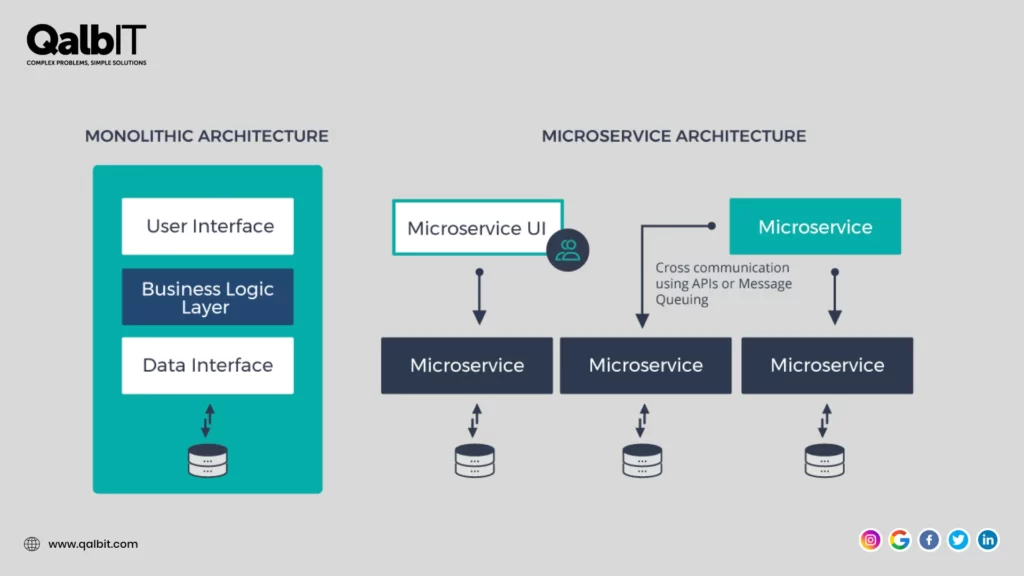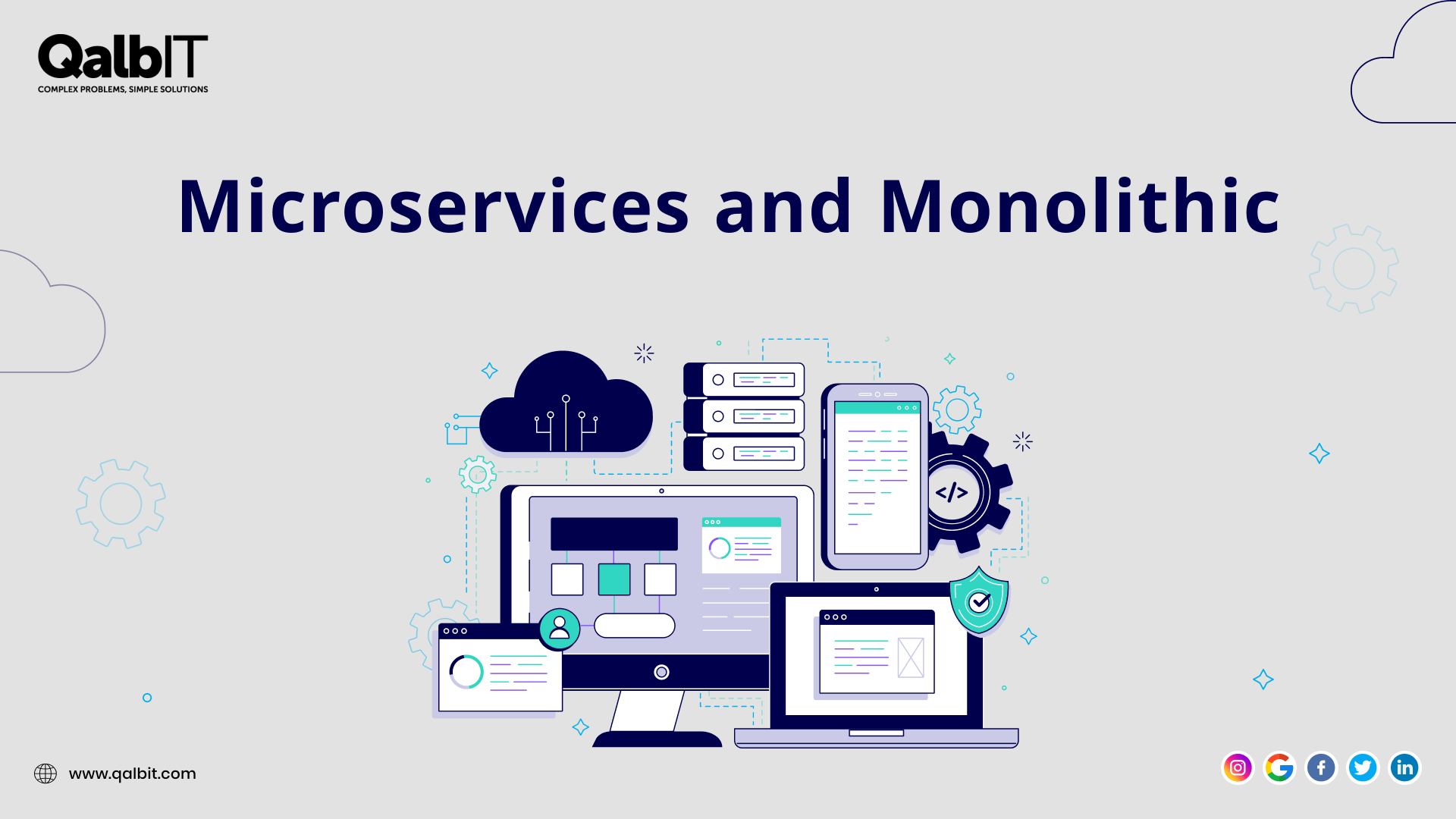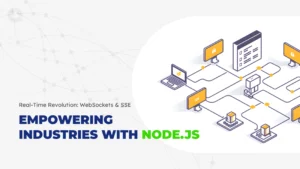
In this Blog, we will discuss about Microservices and Monolithic Architecture in detail and deeper way and the topic we will discuss in this blog are
- Introduction
- Microservices Architecture
- Monolithic Architecture
- Comparison of Microservices and Monolithic Architecture
- Use Case Microservices and Monolithic Architecture
- Explain in detail Pros and Cons of each Architecture
- Pros and Cons of Microservices Architecture
- Pros and Cons of Monolithic Architecture
- Migrating from monolithic to microservices
- Microservices and monolithic in practices
- Future of microservices and monolithic Architecture
- Conclusion
1.Introduction
A. Definition of Microservices and Monolithic architecture
Microservices architecture is an approach to software development where an application is built as a set of small, independent services, each serving a specific business capability, and communicating with each other through lightweight protocols. Monolithic architecture, on the other hand, is an approach where the entire application is built as a single, self-contained unit.
B. Purpose of the blog
The purpose of this blog is to provide a comparison between microservices and monolithic architecture, including their advantages and disadvantages, to help readers understand which approach is better suited for their software development needs.
C. Brief overview of Microservices and Monolithic
Microservices architecture is gaining popularity due to its ability to scale and its flexibility. Monolithic architecture has been widely used for a long time and is still the preferred approach for certain types of applications.
2. Microservices Architecture
A. What are Microservices?
Microservices are a software development approach where an application is broken down into small, independent services, each with its own business logic and data storage. Each service communicates with other services through well-defined APIs and protocols.
B. Advantages of Microservices include
- Scalability: Microservices can be scaled independently, allowing for more efficient use of resources and improved performance.
- Resilience: If one microservice fails, it doesn’t bring down the entire application. The other microservices continue to function as expected, making the application more resilient.
- Flexibility: Microservices are independent, making it easier to modify or update specific parts of the application without affecting the rest of the system.
- Speed of Development and Deployment: Microservices can be developed and deployed independently, allowing for faster iteration and delivery of features.
C. Challenges of Microservices include
- Complexity: Developing and maintaining a large number of microservices can be complex, and it requires a high degree of coordination to ensure that all the services are working together seamlessly.
- Debugging and Monitoring: With so many independent services, debugging and monitoring can be challenging, and it requires a sophisticated monitoring and logging system.
- Service Communication: Services need to communicate with each other, which can lead to performance issues and data consistency problems.
- Testing and Integration: Testing and integrating microservices can be challenging, as it requires a more comprehensive testing strategy to ensure that all services are working correctly.

3. Monolithic Architecture
A. What is Monolithic Architecture?
Monolithic architecture is a software development approach where an application is built as a single, self-contained unit, with all the business logic and data storage in one place.
B. Advantages of Monolithic Architecture include
- Simple to Develop: Developing a monolithic application is relatively simple and straightforward, as all the components are located in one place.
- Easy to Debug: Because the entire application is in one place, debugging is straightforward, and any issues can be easily traced.
- Cost Effective: Developing a monolithic application is generally less expensive than developing a microservices application, as there are fewer moving parts.
C. Challenges of Monolithic Architecture include
- Scalability: Monolithic applications are not as scalable as microservices applications, as scaling the entire application requires scaling all its components together.
- Rigid and Inflexible: With all the components in one place, it can be challenging to modify or update specific parts of the application without affecting the entire system.
- Difficulty in Updating or Maintaining: As the application grows, updating or maintaining a monolithic application can be challenging, as changes can have unforeseen impacts on other parts of the system.
- Slow Deployment and Development: Because the entire application needs to be built, tested, and deployed as a single unit, the process can be slow and time-consuming.
4. Comparison between Microservices and Monolithic Architecture
A. Similarities between Microservices and Monolithic Architecture include
- Both are software development approaches for building applications.
- Both require a good understanding of software design and architecture principles.
B. Differences between Microservices and Monolithic Architecture include
- Scalability: Microservices architecture is highly scalable, allowing for scaling of individual services, while monolithic architecture is less scalable, as it requires scaling the entire application.
- Resilience: Microservices architecture is more resilient as it can isolate failures to individual services, while in a monolithic architecture, a single failure can bring down the entire application.
- Flexibility: Microservices architecture is more flexible, allowing for independent development and deployment of services, while monolithic architecture can be rigid and inflexible, requiring updates to the entire system.
- Speed of Development and Deployment: Microservices architecture allows for faster development and deployment of individual services, while monolithic architecture can be slower due to its need for building and deploying the entire application.
- Complexity: Microservices architecture can be more complex to develop and maintain due to the number of independent services and their inter-dependencies, while monolithic architecture is simpler and easier to understand.
- Debugging and Monitoring: Microservices architecture can be more challenging to debug and monitor due to the distributed nature of the services, while monolithic architecture is more straightforward.
- Service Communication: In a microservices architecture, services need to communicate with each other, which can lead to performance issues and data consistency problems. In a monolithic architecture, communication between components is more straightforward.
- Testing and Integration: Testing and integrating microservices can be more complex and time-consuming, as each service needs to be tested and integrated independently, while in monolithic architecture, testing and integration can be simpler, as the entire application is tested and deployed together.
5. Use cases
A. When to choose Microservices?
- Microservices architecture is a good choice in the following scenarios:
- When building complex applications with multiple business domains that can be divided into separate services.
- When there is a need for rapid development and deployment of individual services.
- When the system needs to be highly scalable, resilient, and flexible.
- When the application is expected to handle high traffic and workload.
- When there is a need for independent deployment of services without impacting other services.
B. When to choose Monolithic Architecture?
- Monolithic architecture is a good choice in the following scenarios:
- When building simple applications with a single business domain.
- When there is a tight budget and time constraints for development and deployment.
- When there is no need for high scalability, resilience, and flexibility.
- When the development team is small and has limited resources.
- When the application is expected to handle low traffic and workload.
6. Comparison of Microservices and Monolithic Architecture
A. Differences between Microservices and Monolithic Architecture
- Structure: Microservices architecture is structured as a collection of small, independent services that communicate with each other through APIs. In contrast, Monolithic architecture has a single codebase that contains all of the functionality of the application.
- Deployment: Microservices can be deployed independently of each other, while Monolithic applications need to be deployed as a whole.
- Scalability: Microservices architecture allows for individual services to be scaled independently, while Monolithic applications can only be scaled as a whole.
- Maintenance: Microservices are easier to maintain as each service can be updated independently without affecting the entire application. On the other hand, Monolithic applications require more effort to maintain as changes made to one part of the application can affect the entire system.
B. When to use Microservices and when to use Monolithic Architecture
- Microservices: Microservices architecture is recommended for large-scale applications that require flexibility, scalability, and continuous delivery. It is ideal for complex systems that require different technologies, programming languages, and databases.
- Monolithic Architecture: Monolithic architecture is recommended for small-scale applications that do not require continuous development and deployment. It is suitable for applications that require a simple, cohesive structure with a single codebase.
7. Pros and Cons of Microservices Architecture
A. Pros of Microservices Architecture
- Scalability: Microservices architecture allows individual services to be scaled independently. This means that resources can be allocated more efficiently and only the necessary components are scaled to handle the required workload.
- Fault Isolation: Microservices architecture provides fault isolation, meaning that when a failure occurs in one service, the other services remain unaffected. This leads to increased uptime and availability of the application.
- Independent Deployment: Microservices can be deployed independently of each other. This means that a change in one service doesn’t require the redeployment of the entire application. This allows for faster deployment and continuous delivery.
- Better Fault Tolerance: In Microservices architecture, a single point of failure is less likely to bring down the entire system. Services are designed to handle faults gracefully, which reduces the likelihood of system-wide outages.
B. Cons of Microservices Architecture
- Complex Architecture: Microservices architecture is a complex architecture that can be difficult to design, develop, and maintain. It requires careful consideration of service boundaries and inter-service communication to ensure that the application runs smoothly.
- Increased Development and Operational Costs: Microservices architecture requires more resources, both in terms of development time and infrastructure costs. It requires more development effort to build and maintain multiple services, and the infrastructure costs can be higher due to the need for multiple databases and other resources.
- Testing and Debugging: Testing and debugging in a Microservices architecture can be challenging, as it requires coordination between multiple services. Changes in one service can have an impact on other services, so testing and debugging require a holistic approach.
- Communication Between Services: Communication between services in a Microservices architecture can be difficult. It requires careful design and implementation of APIs to ensure that services can communicate effectively.
8. Pros and Cons of Monolithic Architecture
A. Pros of Monolithic Architecture
- Simple Architecture: Monolithic architecture has a simple architecture that is easy to design and develop. The application has a single codebase, which makes it easier to maintain and update.
- Easy to Develop and Test: Monolithic architecture is easy to develop and test, as there is only one codebase to deal with. This makes it easier to ensure that the application is running smoothly.
- Low Operational Cost: Monolithic architecture has a lower operational cost than Microservices architecture. It requires fewer resources and infrastructure to maintain, which makes it more cost-effective.
- Communication Between Components: Communication between components in a Monolithic architecture is easy. As all the components are part of the same application, communication can be done easily and efficiently.
B. Cons of Monolithic Architecture
- Lack of Scalability: Monolithic architecture does not offer the same scalability as Microservices architecture. Scaling the entire application can be difficult, which can lead to resource wastage.
- Difficult to Maintain and Update: As Monolithic architecture has a single codebase, maintaining and updating the application can be difficult. Changes in one component can have an impact on the entire application, which can make it hard to keep the application up-to-date.
- Limited Fault Tolerance: Monolithic architecture does not provide the same level of fault tolerance as Microservices architecture. If a component fails, it can bring down the entire application.
- Not Suitable for Large-Scale Applications: Monolithic architecture is not suitable for large-scale applications as it can become too complex to maintain and update. As the application grows, it can become harder to scale and manage efficiently.
9. Migrating from Monolithic to Microservices
A. Steps involved in migrating from Monolithic to Microservices
- Analyze and understand the existing monolithic application and identify the services that can be decoupled and made independent.
- Design and plan the new Microservices architecture, including service boundaries and inter-service communication protocols.
- Choose the right technology stack for each service, considering the programming language, frameworks, and data stores.
- Develop and test each service independently, including unit testing, integration testing, and functional testing.
- Deploy and monitor each service independently, including automation of deployment and monitoring.
- Update the existing application to communicate with the newly created services and gradually decompose the monolithic application into smaller, independent services.
- Monitor and fine-tune the Microservices architecture to optimize performance, scalability, and reliability.
B. Best practices for migrating to Microservices
- Start small and decouple one service at a time, gradually migrating the application to Microservices architecture.
- Use a containerization tool like Docker to create lightweight, independent services that can be easily deployed and scaled.
- Use a service registry like Consul or Eureka to manage service discovery and registration.
- Implement an API gateway to manage API access and security.
- Use a centralized logging and monitoring tool like ELK stack or Prometheus to monitor and troubleshoot Microservices.
C. Common challenges of migrating from Monolithic to Microservices
- Ensuring that the new Microservices architecture does not compromise application performance and scalability.
- Managing data consistency and availability across multiple services.
- Identifying and decoupling the right services, ensuring that each service has a clearly defined purpose.
- Handling cross-service communication, including service discovery and API versioning.
- Managing the complexity of multiple services and ensuring that each service is monitored and maintained independently.
- Providing security and access control across multiple services.
- Ensuring that the new Microservices architecture does not break existing functionality or create new bugs.
10. Microservices and Monolithic in Practice
A. Real-world examples of companies using Microservices and Monolithic Architecture
1). Microservices:
- Netflix: Netflix uses Microservices architecture to support its streaming service, with more than 700 individual services that run independently.
- Amazon: Amazon’s e-commerce platform is built on Microservices, with more than 100,000 services running at any given time.
- Uber: Uber’s ride-hailing platform uses Microservices architecture to manage its complex infrastructure and handle high-volume data processing.
2). Monolithic:
- Microsoft: Microsoft Office Suite is a classic example of Monolithic architecture, with all the features and functionalities bundled together in a single application.
- SAP: SAP uses Monolithic architecture for its enterprise resource planning software, with all the modules integrated into a single application.
- Oracle: Oracle’s database software is built on Monolithic architecture, with all the database management features and functionalities integrated into a single application.
B. The success stories of companies using Microservices and Monolithic Architecture
1). Microservices:
- Netflix: By using Microservices architecture, Netflix is able to achieve high scalability and availability, with the ability to handle millions of users and billions of requests per day.
- Amazon: Amazon’s e-commerce platform, built on Microservices architecture, is able to handle high-volume traffic and provide personalized recommendations and product suggestions.
- Uber: Uber’s ride-hailing platform, built on Microservices architecture, is able to handle complex data processing and provide real-time navigation and tracking.
2). Monolithic:
- Microsoft: Microsoft Office Suite, built on Monolithic architecture, is widely used by businesses and individuals for its extensive features and functionalities.
- SAP: SAP’s Monolithic architecture allows for seamless integration of all the modules, providing a comprehensive solution for enterprise resource planning.
- Oracle: Oracle’s Monolithic architecture provides a robust and reliable database management system for businesses of all sizes.
11. Future of Microservices and Monolithic Architecture
A. Trends and predictions of Microservices and Monolithic Architecture
1). Microservices:
- More adoption in enterprise applications: As more companies look to modernize their IT infrastructure and move towards cloud-based solutions, Microservices architecture is expected to gain more adoption in enterprise applications.
- Increase in the use of server less computing: With the rise of server less computing, Microservices architecture is expected to become even more popular as it allows for greater flexibility and agility in application development.
- Greater use of containerization: The use of containerization technologies like Docker and Kubernetes is expected to increase as more companies adopt Microservices architecture.
2). Monolithic:
- Legacy systems and maintenance: Monolithic architecture is expected to continue to be used for legacy systems that are difficult to migrate to a Microservices architecture, or where maintenance and support are still required.
- Use in smaller applications: Monolithic architecture is expected to be used for smaller applications where the simplicity of a single codebase is preferred over the complexity of a Microservices architecture.
- Hybrid approach: Some companies may choose to adopt a hybrid approach, combining both Microservices and Monolithic architecture to create a more flexible and scalable architecture.
B. The role of these architectures in modern application development
1). Microservices:
- Flexibility and agility: Microservices architecture provides greater flexibility and agility in application development, allowing for faster and more frequent releases.
- Scalability: Microservices architecture allows for greater scalability, making it ideal for applications with high traffic and variable workloads.
- Cloud-native: Microservices architecture is cloud-native, making it ideal for applications that are hosted in the cloud.
2). Monolithic:
- Simplicity: Monolithic architecture is simpler to develop, deploy, and maintain, making it ideal for smaller applications.
- Familiarity: Monolithic architecture is a familiar architecture for developers who have been using it for a long time, making it easier to develop and maintain.
- Legacy systems: Monolithic architecture is often used for legacy systems that cannot be easily migrated to a Microservices architecture.
12. Conclusion
In conclusion, the comparison between Microservices and Monolithic Architecture has shown that both have their own strengths and weaknesses, and the choice of architecture depends on the specific needs and requirements of the application. Migrating from Monolithic to Microservices architecture requires careful planning and execution, and it is important to follow best practices and address common challenges. Companies that have successfully adopted Microservices architecture have demonstrated the benefits of this architecture, including greater flexibility, scalability, and the ability to handle complex applications and data processing. In the future, Microservices architecture is expected to gain more adoption in enterprise applications, while Monolithic architecture is expected to continue to be used for legacy systems and smaller applications. Ultimately, the success of an architecture depends on how well it is implemented and how effectively it meets the needs of the application.
Frequently asked questions
Microservices architecture should be chosen for large, complex applications that require frequent updates and a high level of scalability.
Monolithic architecture should be chosen for smaller applications and systems that do not require the flexibility and scalability of Microservices architecture.
Best practices for migrating from Monolithic to Microservices architecture include conducting a thorough assessment of the existing architecture, breaking down the application into independent services, and implementing a modular design.
Yes, it is possible to use both Microservices and Monolithic architecture in an application, however, this can create complexity and add overhead to the application. It is important to carefully evaluate the benefits and drawbacks of each architecture before making a decision.






